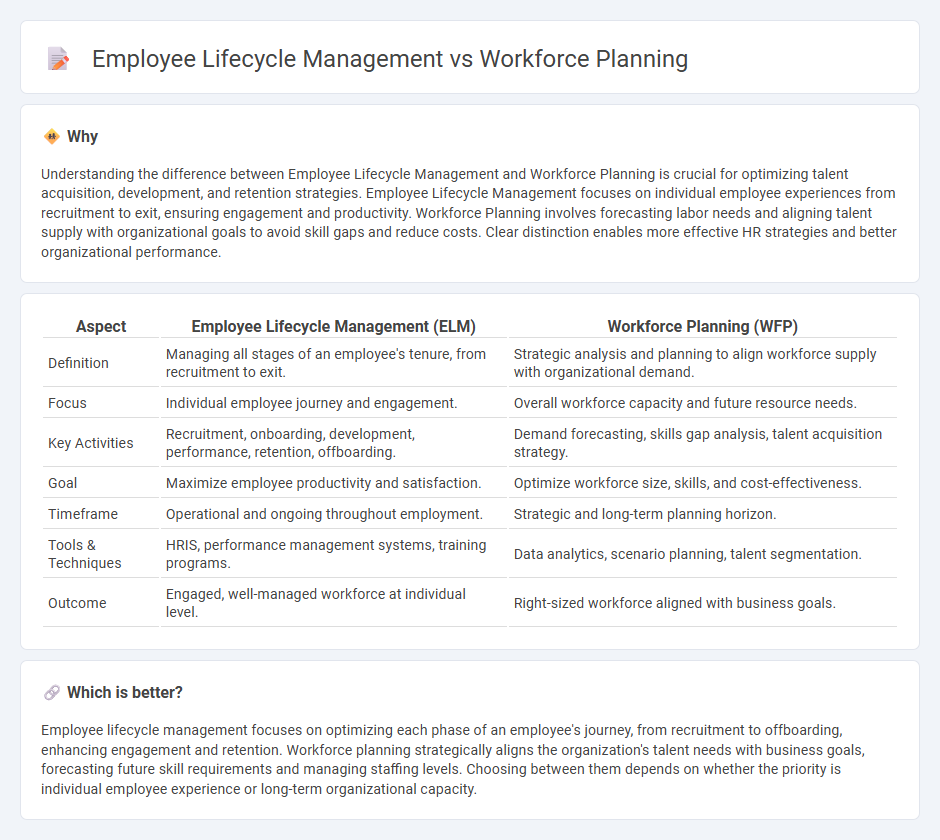
Employee lifecycle management focuses on overseeing each stage of an employee's tenure, from recruitment and onboarding to development and offboarding, ensuring optimal engagement and productivity. Workforce planning involves strategic forecasting and allocation of talent resources to meet long-term organizational goals and adapt to market changes. Discover how integrating these approaches can enhance HR effectiveness and business performance.
Why it is important
Understanding the difference between Employee Lifecycle Management and Workforce Planning is crucial for optimizing talent acquisition, development, and retention strategies. Employee Lifecycle Management focuses on individual employee experiences from recruitment to exit, ensuring engagement and productivity. Workforce Planning involves forecasting labor needs and aligning talent supply with organizational goals to avoid skill gaps and reduce costs. Clear distinction enables more effective HR strategies and better organizational performance.
Comparison Table
| Aspect | Employee Lifecycle Management (ELM) | Workforce Planning (WFP) |
|---|---|---|
| Definition | Managing all stages of an employee's tenure, from recruitment to exit. | Strategic analysis and planning to align workforce supply with organizational demand. |
| Focus | Individual employee journey and engagement. | Overall workforce capacity and future resource needs. |
| Key Activities | Recruitment, onboarding, development, performance, retention, offboarding. | Demand forecasting, skills gap analysis, talent acquisition strategy. |
| Goal | Maximize employee productivity and satisfaction. | Optimize workforce size, skills, and cost-effectiveness. |
| Timeframe | Operational and ongoing throughout employment. | Strategic and long-term planning horizon. |
| Tools & Techniques | HRIS, performance management systems, training programs. | Data analytics, scenario planning, talent segmentation. |
| Outcome | Engaged, well-managed workforce at individual level. | Right-sized workforce aligned with business goals. |
Which is better?
Employee lifecycle management focuses on optimizing each phase of an employee's journey, from recruitment to offboarding, enhancing engagement and retention. Workforce planning strategically aligns the organization's talent needs with business goals, forecasting future skill requirements and managing staffing levels. Choosing between them depends on whether the priority is individual employee experience or long-term organizational capacity.
Connection
Employee lifecycle management and workforce planning are interconnected processes that optimize talent acquisition, development, and retention to meet organizational goals. Workforce planning identifies future staffing needs based on business objectives, while employee lifecycle management ensures seamless onboarding, performance management, and offboarding aligned with these projections. Together, they enhance productivity, reduce turnover costs, and support strategic HR decision-making.
Key Terms
**Workforce planning:**
Workforce planning involves strategically analyzing and forecasting an organization's current and future workforce needs to align talent acquisition, development, and retention with business goals. It includes demand forecasting, talent gap analysis, and succession planning to ensure the right skills are available at the right time. Explore more about how workforce planning drives organizational agility and competitive advantage.
Talent forecasting
Workforce planning involves analyzing current workforce capabilities and predicting future talent needs to align with organizational goals, emphasizing data-driven talent forecasting. Employee lifecycle management tracks employee experience from recruitment through retention and separation, focusing on optimizing each stage to enhance workforce productivity. Explore the strategic differences between these approaches to improve your organization's talent forecasting efficiency.
Succession planning
Workforce planning strategically analyzes current and future talent needs to ensure the right skills are available, emphasizing succession planning to identify and develop internal candidates for critical roles. Employee lifecycle management tracks the entire employee experience from recruitment to exit, incorporating succession planning to ensure seamless leadership transitions and retention of institutional knowledge. Explore more about how succession planning integrates within these frameworks to strengthen organizational resilience.
Source and External Links
What Is Workforce Planning? Strategies and Benefits - Workforce planning is the process of analyzing an organization's future staffing needs and developing strategies to meet those requirements, including assessing current workforce, forecasting future needs, identifying skill gaps, and implementing action plans.
Workforce Planning: Definition, Process and Principles - It involves reviewing organizational objectives, conducting supply and demand analyses of talent, and planning to ensure the right people are in place to achieve business goals.
Workforce Planning - This process ensures an organization has the right people, with the right skills, in the right places at the right time by analyzing, forecasting, and planning workforce supply and demand, then implementing targeted talent management interventions.
 dowidth.com
dowidth.com